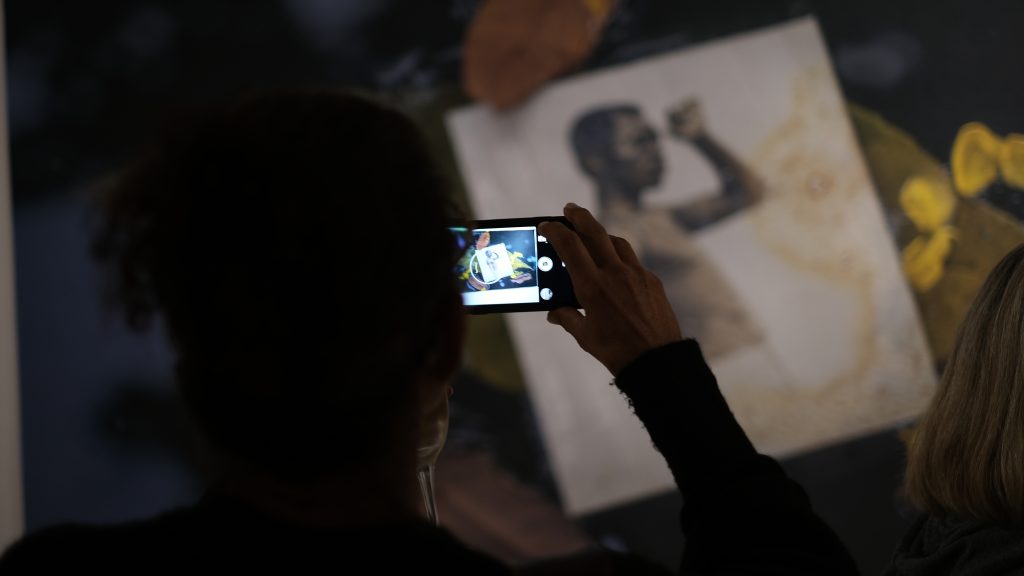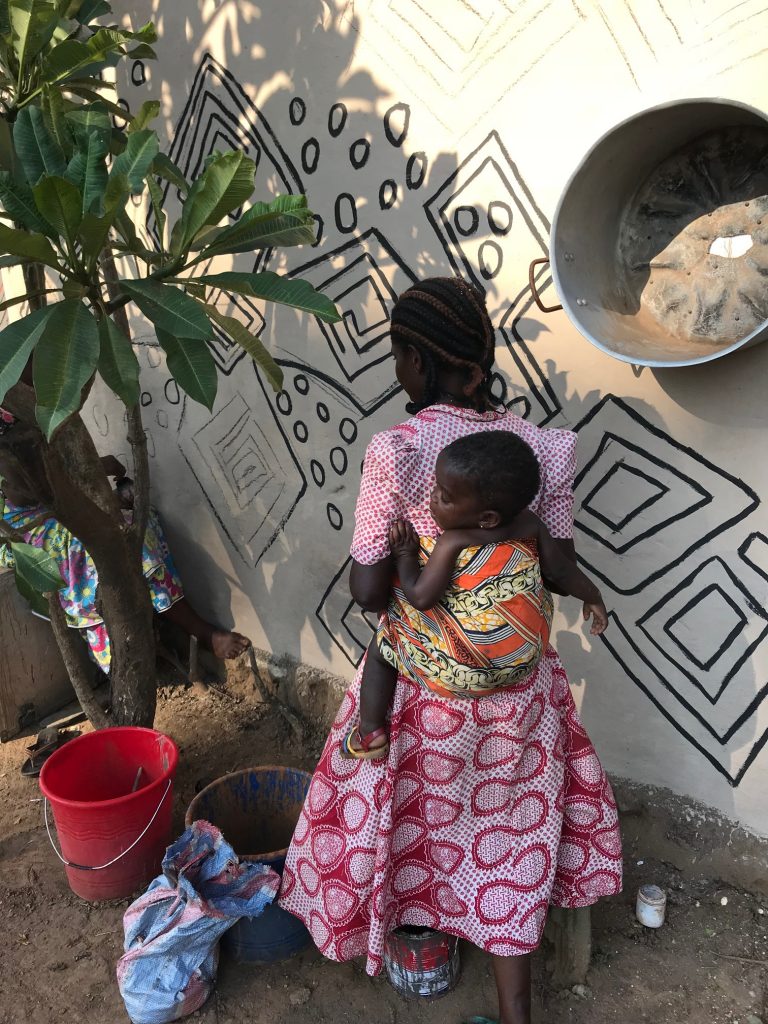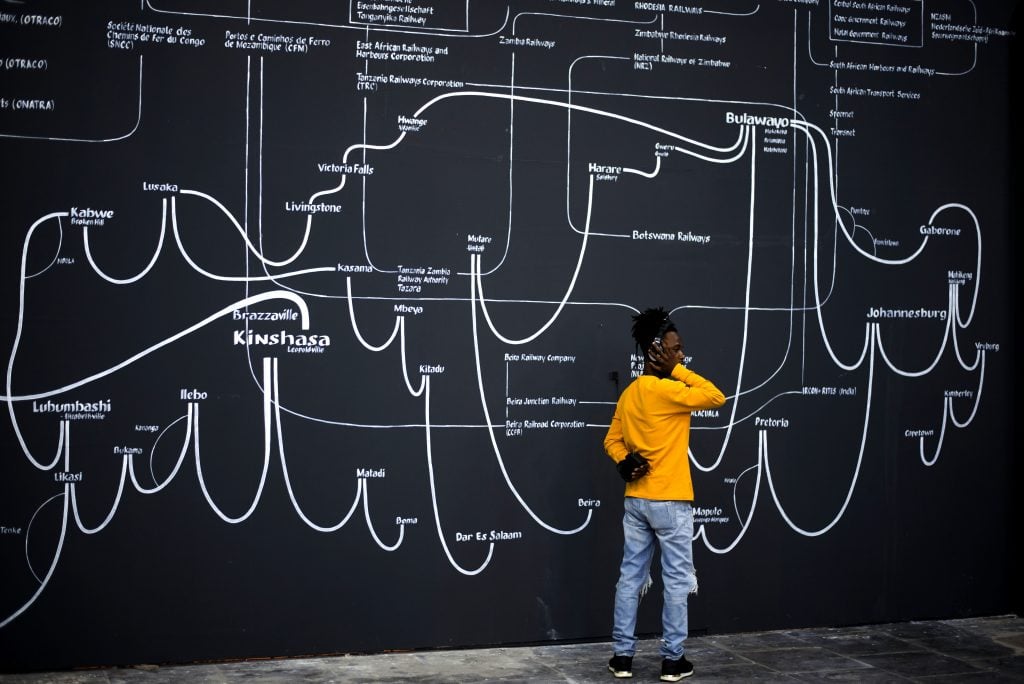Artnet News Pro
With Local Investment and Rising Auction Prices, Is the Democratic Republic of Congo Poised to Become Africa’s Next Art Hub?
The central African country could be following the trajectory of the exploding scenes in West Africa.

The central African country could be following the trajectory of the exploding scenes in West Africa.

Rebecca Anne Proctor

A man wearing a silver suit and silver bucket for a helmet walks down a busy dirt street in a ghetto in Kinshasa.
This is just an ordinary day in the Democratic Republic of Congo (DRC)’s capital and most populous city of 17 million, and the Kongo Astronaut, with his suit plastered with digital debris made from minerals mined in Congo, has become an ordinary, almost ritualistic sighting. It is a performance organized by an artist collective founded by Kinshasa-based duo Michel Ekeba and Eléonore Hellio that aims to surmount the postcolonial chaos that defines the city’s urban landscape by placing a spotlight on the forces that have shaped it: capitalism, climate change, and geopolitics. “Art is everywhere, and Kinshasa is a performance,” Freddy Tsimba, one of DRC’s rising artists, told Artnet News.
As the art world deepens its fixation with art from Africa and its diasporas, and other creative hubs on the continent—namely, the West African nations of Ghana and Nigeria—continue to attract regional and international attention, the emergent art scene in DRC and its defiant and vocal artists is gaining chatter as the next big hub for art on the continent.
Yet Congo has long had a bad rep, and until recently, was never seen as a hub for art. Often viewed as one of the world’s last and most challenging frontier economies, when one thinks of Congo, what might come to mind is Joseph Conrad’s novel Heart of Darkness (1899) criticizing European colonial rule in Africa, or the movie Blood Diamond (2006) telling the tale of diamonds mined in war zones. Now its artists, patrons and collectors are striving to give the country a new identity and the international art scene is watching and recognizing its potential.
“Everything that you hear about Congo in the media is bad news and what we are trying to do is to show Congo under a different light,” Baraka Rumamba, a Congolese entrepreneur, real estate investor and founder of Yetu Management, an organization that promotes Congolese art, told Artnet News. “Art acts as a better PR than currently exists for DRC.”

Installation view from “Breaking the Mould” at 198 Gallery in London.
While prices for contemporary Congolese artists have steadily risen in value since the main auction houses began selling contemporary modern and African art in 2009, it is rare that they crack the triple-digit range enjoyed by some of their West African counterparts. Exceptions include Chéri Samba—who remains the DRC’s best-known artist and whose works have fetched up to $140,000 at auction—and Eddy Ilunga Kamuanga, whose paintings first appeared on the secondary market in 2017 for £11,000, and now reach over £100,000 ($135,000), according to artnet’s Price Database.
The rising value and interest in contemporary art from DRC is reflective of a growing scene. In October 2018 Bonhams presented a 22-lot section in its regular Africa sale in London titled “Bienvenue au Congo,” including works by Freddy Tsimba, Aime Mpane, and Patrick Bongo, with 70 percent of the lots sold at an average price of £5,000–£8,000.
“There is no doubt that a similar sale in today’s market would be averaging over £15,000 ($20,000),” Giles Peppiatt, director of South African and modern and contemporary African art at Bonhams, told Artnet News. Indeed, a work by Aime Mpane fetched $18,825 at a Bonhams New York sale in 2019.
Other rising markets include that of late multimedia artist Bodys Isek Kingelez, known for his dazzling architectural sculptures that he referred to as “extreme maquettes” representative of the imagined dreams and cities of DRC. Kingelez was the subject of a solo exhibition at MoMA in 2018. His work began to come to auction around 2015 with prices reaching around £6,000-£10,000. “In 2020 and 2021 these works are regularly fetching £30,000-£50,000 ($40,000–$67,000),” Peppiatt said.
Sotheby’s has also witnessed a rise in value for Congolese art since its inaugural sale in 2017. “The Congolese art market has had a huge hub in Europe and not in Congo itself for a long time and now you are slowly seeing this transition to where the national market is growing,” Adriana La Lime, a Sotheby’s specialist in modern and contemporary African art told Artnet News. “In our sales we have other Europeans, Americans and other Africans that are now interested in Congolese art which is a positive sign.”
The reason Congolese artists aren’t yet seeing the same prices as their counterparts in Nigeria, Ghana and South Africa, La Lime said, “is due to a lack of local patronage and support in the form of galleries, institutions and collectors. This is the big challenge facing the Congo art scene right now.”

Image courtesy Atelier Picha.
In DRC there are no commercial art galleries, very few museums, and no government support for the arts. “Art and culture is not a priority for them,” artist and curator Vitshois Mwilambwe Bondo told Artnet News. Bondo set up the Kin ArtStudio in 2011, which includes an artist residency in Kinshasa for Congolese and international artists, and the Congo Biennial, which will stage its second edition in Kinshasa from September 16 to October 23, 2022. Bondo said he receives private financial support to run his initiatives.
For Congolese wishing to study art, there is one school in Kinshasa: the Académie des Beaux-Arts, which has followed a strict 19th-century style of formal figuration since its colonial-era founding in 1943. Eddy Ilunga Kamuanga abandoned his studies there in 2011. “I revolted against the classicism of the school, inherently European in approach,” Kamuanga told Artnet News. “I wanted to express myself in other ways.” After Kamuanga left, he founded M’Pongo group with other young Congolese artists.
Over the last 15 years artists like Bondo have been hoping to boost the country’s artistic profile through establishing biennial exhibitions. These include the Lubumbashi Biennial and the Kinsasha Biennial. The latter, founded by Congolese photographer Kiripi Katembo Siku, staged only one edition in 2014. Its mission was to change the perception of Congo from a poor, corrupt and war-torn country.
The former, founded in 2008, is also artist-led, set up by Lubumbashi-based Atelier Picha—which means “picture” in Swahili—an art center co-founded by artists and cultural producers, including artist Sammy Baloji, Gabriele Salmi and Jean Katambayi. The upcoming Lubumbashi Biennial in the fall will be dedicated to the idea of toxicity as a condition of existence, and its effects on various societies.
In terms of museums, in 2019 the country inaugurated its National Museum of the Democratic Republic of Congo (MNRDC) in Kinshasa—though the $22 million institution was funded by the South Korean International Cooperation Agency, a state-run aid organization in the hope, it said, of preserving cultural artifacts to encourage Congolese to forge a sense of national unity. It is dedicated to the cultural history and various ethnic groups of DRC. There’s also the controversial White Cube of Dutch artist Renzo Martens situated in the middle of a Congolese palm oil plantation in Lusanga since 2017 with a mission to jump start the local economy through art.

The 2019 Congo Biennial. Photo by Nicolas Patience Basabose.
The contemporary artists of DRC today are creating art with a mission. Like the Kongo Astronaut, it is an art of socio-political advocacy and one that aims to change the African and Congolese narrative. What is missing in this scene of great potential is structure. But it seems DRC is at an artistic turning point. Entrepreneur Rumamba confirms that he intends to open a commercial gallery in Kinshasa next year through Yetu Management. Whispers can be heard of other galleries opening in Kinshasa—and the talk is reminiscent of the talk that could be heard just a few years ago in West African scenes that have recently exploded.
“We are underrepresented in the African and international art scene,” Congolese art collector and investor Alain Defise told Artnet News. He recently bought several works from “Breaking the Mould,” an exhibition that took place in October 2021 showcasing the work of 12 emerging artists from the DRC at 198 Gallery in London. “People mention Ghana, Nigeria, South Africa and Morocco, but very few mention Congo,” We have always had the creativity. If we could replicate in contemporary art the success we’ve had in music where we inundate the whole continent with our creativity, look at the potential we could have.”
For the artists like Kamuanga determinedly pushing the scene forward, the hope is that the international art world will soon take notice.